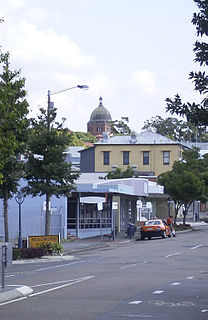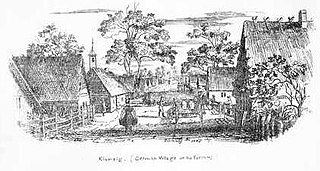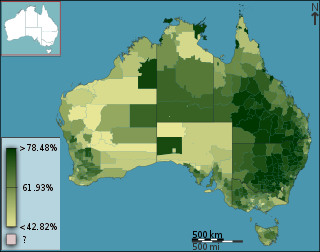
The Samoan Islands were first settled some 3,500 years ago as part of the Austronesian expansion. Both Samoa's early history and its more recent history are strongly connected to the histories of Tonga and Fiji, nearby islands with which Samoa has long had genealogical links as well as shared cultural traditions.

German New Guinea consisted of the northeastern part of the island of New Guinea and several nearby island groups and was the first part of the German colonial empire. The mainland part of the territory, called Kaiser-Wilhelmsland, became a German protectorate in 1884. Other island groups were added subsequently. New Pomerania, the Bismarck Archipelago, and the northern Solomon Islands were declared a German protectorate in 1885; the Caroline Islands, Palau, and the Mariana Islands were bought from Spain in 1899; the protectorate of the Marshall Islands was bought from Spain in 1885 for $4.5 million by the 1885 Hispano-German Protocol of Rome; and Nauru was annexed to the Marshall Islands protectorate in 1888.

John Dunmore Lang was a Scottish-born Australian Presbyterian minister, writer, historian, politician and activist. He was the first prominent advocate of an independent Australian nation and of Australian republicanism.

The Myall Creek massacre involved the killing of at least twenty-eight unarmed Indigenous Australians by twelve colonists on 10 June 1838 at the Myall Creek near the Gwydir River, in northern New South Wales. After two trials, seven of the twelve colonists were found guilty of murder and hanged. One—the leader and free settler John Fleming—evaded arrest and was never tried. Four were never retried following the not guilty verdict of the first trial.

Nundah is an inner suburb in the City of Brisbane, Queensland, Australia. In the 2016 census, Nundah had a population of 12,141 people.

Wujal Wujal is a rural town and locality in the Wujal Wujal Aboriginal Shire, Queensland, Australia. In the 2016 census, Wujal Wujal had a population of 282 people. It is an Aboriginal community.

German settlement in Australia began in large numbers in 1838, with the arrival of immigrants from Prussia to Adelaide, in the then colony of South Australia. German immigrants became prominent in settling South Australia and the Queensland. From 1850 until World War I, German settlers and their descendants comprised the largest non-British or Irish group of Europeans in Australia.
German Australians are Australian citizens of ethnic German ancestry. The German community constitutes one of the largest ethnic groups in Australia, numbering 982,266 or 3.8 percent of respondents in the 2016 Census. It is the fifth most identified European ancestry in Australia behind English, Irish, Scottish and Italian.

The presence of Christianity in Australia began with the foundation of a British colony at New South Wales in 1788. Christianity remains the largest religion in Australia, though declining religiosity and diversifying immigration intakes of recent decades have seen the percentage of the population identifying as Christian in the national census decline from 96.1% at the time of the Federation of Australia in the 1901 census, to 52.1% in the 2016 census.
The Reverend Lancelot Edward Threlkeld was an English missionary, primarily based in Australia. He was married twice and survived by sons and daughters from both marriages. His work in Australia did much to increase knowledge of Aboriginal languages, but he had little success with converting Aborigines to Christianity.

Christoph Eipper was a pioneering missionary and Presbyterian minister in Australia.
The Turrbal are an Aboriginal Australian people from the region of present-day Brisbane, Queensland. The name primarily referred to the dialect they spoke, the tribe itself being alternatively called Mianjin/Meanjin. Mianjin was the Turrbal word for the central Brisbane area. The traditional homelands of the Turrbal stretch from the North Pine River, south to the Logan River, and inland as far as Moggill, a range which includes the city of Brisbane.

Nundah Cemetery is a heritage-listed cemetery at 88 Hedley Avenue, Nundah, City of Brisbane, Queensland, Australia. It was built from 1840s to 1963. It is also known as German Station Cemetery. It was added to the Queensland Heritage Register on 21 October 1992.

Johann Leopold Zillmann (1813–1892) was a German missionary to Australia. Born in Neu-Ulm, and a blacksmith by trade, he joined Carl Wilhelm Schmidt and Christopher Eipper at the Zion Hill Mission in what is now the Brisbane suburb of Nundah in Queensland. After the mission closed, Zillmann stayed in the area and turned to farming.

The Zion Hill Mission was a Christian mission founded in the area now known as Nundah, Queensland by German Lutheran missionaries. The mission is notable as being the first free European settlement in what is now the state of Queensland. Despite limited success at converting the local Aboriginal Australians to Christianity, many of the missionaries later became pioneers and farmers in the district, shaping the social fabric of the North Brisbane area for decades to come.

Johann Christian Simon Handt was a German-born Australian minister and missionary of Lutheran faith. Known for being Queensland's first missionary or one of the first, Handt is also said to have brought in the first pineapples in Queensland.

First Free Settlers Monument is a heritage-listed memorial at Sandgate Road, Nundah, City of Brisbane, Queensland, Australia. It was built in 1938. It is also known as First Free Settlers of Queensland Memorial Cairn. It was added to the Queensland Heritage Register on 26 June 1998.
The Undanbi were an indigenous Australian tribe of southern Queensland.
The War of Southern Queensland was a conflict fought between a coalition of Aboriginal tribes in South East Queensland, the "United Tribes", and the United Kingdom of Great Britain and Ireland, from around 1843 to 1855. Following the Kilcoy massacre in 1842, a great meeting was held in the Bunya Scrub of tribes from across South East Queensland north to the Wide Bay-Burnett and Bundaberg regions, fuelled by decades of mistrust and misunderstanding with the British, they united into a loose confederation and issued a ‘declaration’ to destroy the settlements on their lands.















